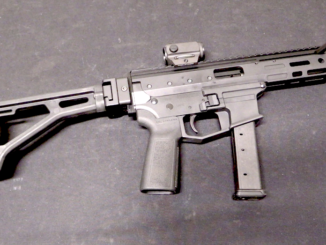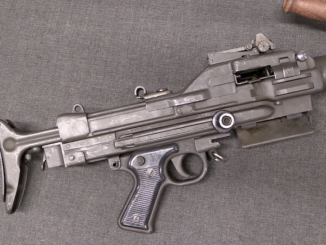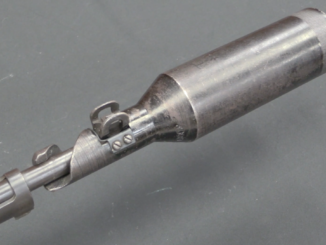Thanks to the awesome people supporting Forgotten Weapons through Patreon for sending in more questions that I could get to for another month!
This month the subjects include:
- Browning lock vs others in handguns
- Best modern weapon for WWI
- Turret revolvers
- Affordable “forgotten weapons”
- Welrod pistol
- C&R rifle parts sources WWII souvenir?
- Finnish firearms
- Garage-built firearms that hit it big
- What guns ought to be reproduced today?
- My own background
- Early striker-fired pistols
And more!




Guns that somebody ought to reproduce? That’s easy: the Winchester 1895 Russian! Yes, long bbl and stock, clip bridge, sling swivels, sight graduated in “lines,” bayonet lug if the law allows — iow, the exact rifle the Czar wanted. Who knows? Some of the old tools and dies may still exist somewhere! They’d fly off the shelves on the wings of angels!
As a Pedersen designs fan I will say: Remington Model 121 or Remington Model 25 or Remington Model 141 or Remington Model 17.
Once IMI produced fire-arm externally similar to Model 25: IMI Timber Wolf, i don’t know that is knock-off of Model 25 or total different design only similar externally.
From other fire-arms: Newton Leverbolt, also pre-paid system looks to be good to detecting whetever need for this or that fire-arm is big enough to start production. If many enough orders were collected then production start, else return money to customers.
Ian,
What a day job is all I can say. The one responce is I agree on the turret revolver. I have a reproductions 1858 Remington New Model Army cap and ball and have fired it. Wore a heavy glove for safety. And the biggest downer on black powder is the clean up.
Could you post your reference list? I have several books bought back in the 1980’s and 1990’s. A lot of what you have shown is in there but a lot is not.
Any word on 2016 calendar ?
On the Issue of Fluting the chambers, and potentially a reproduction, Do you think Fluting the chamber on the Pedersen Rifle would have fixed the need for the Wax coated ammo? A couple of Friends of mine are Machinists and engineers, and we have been tinkering with the Idea of Reproducing either Hard to find guns, or Guns with traditionally hard to find ammunition (SVD’s and Common Caliber Arisakas seem like they’re what we’re going to start with in a few years). Anyway, we came to talking about reproducing Pedersen Rifles in a Semi-Common caliber of 6.8 SPC, and were wondering what your opinion on fluting the chamber to get around the Lubed Ammo
I don’t want to discourage you, but redesigned Pedersen system to different cartridge might be hard problem, considering that (see US 1907 trials) that .45 Luger don’t work properly as it was balanced for 200 grain bullet rather than newer 230 grain, other fire-arms has not that problem.
“get around the Lubed Ammo”
I suspect that fear against lubing cartridges is excessive and exaggerated.
Anyway, if you want fluted chamber, dimensions for ShKAS chamber are as follows:
14 grooves
depth: 0,6mm
width: from 0,55mm to 0,5mm (most far from chamber axis)
grooves starts 60,72mm (from chamber base) ends 10,??mm (from chamber base)
“Common Caliber Arisakas”
I’m not sure about nowadays cartridges popularity in US, but is 7×57 Mauser (also known as 7×57 Spanish and under many other names) popular? If so so-called Mexican Arisaka might be interesting option (rifles produced in Japan for Mexico, but never delivered due to Mexican Revolution, after WW1 broke out they were bought by Imperial Russia as they need any rifles in any quantity, source: http://www.hungariae.com/Arisaka.htm )
Speaking of reproducing, I’d personally love to see the Mexican Model 1954 Mauser in .30-06 back in production.
cheers
eon
“Turret” revolvers have a long and not that distinguished history, starting with the ribauldequin;
https://en.wikipedia.org/wiki/Ribauldequin
While most “organ guns” had barrels in a fan or parallel layout, some had them mounted like the spokes of a wheel, on a vertical shaft. The idea being that rather like Leonardo’s proposal of sixty barrels in three groups of twenty on a rotating triangle, while one or two barrels were firing, another pair could be cooling and two more could be reloading. Handy thing to have on the battlements during a siege.
That is until the gun crews realized that in event of a “gangfire” multiple discharge when three or more barrels were loaded, at least one or two would most likely be pointed back at them.
This is the fundamental drawback of any such weapon using muzzle-loading technology. An MD on a Colt Revolving Rifle can destroy the shooter’s off hand if he’s holding it normally. An MD on a turret weapon can potentially kill the shooter and cripple or kill anyone close to him on either side or behind him.
BTW, one of the biggest (and one of the last) such weapons was the Civil War era Gorgas machine gun, really more of a light cannon;
http://www.ibiblio.org/hyperwar/USN/ref/MG/I/img/MG-1-033-9.jpg
1.25″ smooth bore, 18 chambers, hand-cranked, and yes, all chambers were loaded and capped at the start.
Only one was ever built. I’m surprised that Josiah Gorgas, who was after all an Ordnance officer before Fort Sumter, even considered it for a second.
cheers
eon
As for affordable “forgotten weapons”, Ian mentioned French revolvers. The Spanish S&W copies are quite cheap and quite fun (and at least mine is actually quite good), but really require handloading.
Also, the various Belgian Bulldog copies are interesting pieces – I have a pre-WW1 version in 7.5mm Swiss ordnance (which I can do a guest post on if Ian is interested, like I did for the Spanish-made French revolver a while back). They’re surprisingly interesting little pieces, with some interesting mechanical features. For instance, on my one you *can* have the hammer touching the primer of a cartridge, but you have to do it deliberately – it’s quite cleverly arranged so that you can’t do it by accident.
Great question and answer session, congratulations!
Two comments:
1 – Revolver type barrels on automatics. Note that these are all full power weapons, the P.08, the P.38 and the C.96, which means the barrel recoils a little when fired. In the C.96 the barrel is fixed to a long slide, the breech block working inside it. The Luger slide is much shorter, and I’m not sure about the P.38, but I think it’s shorter still. To make these weapons accurate, the barrel must be in perfect alignment at the moment of firing and as long as the bullet is in the barrel. Any waving about will wreck the accuracy, this means they must be tight fit weapons, the shorter the supporting track the smaller the allowed play. That is why P.08’s wore out so easily, my father was in the RAF during the war and had a Luger he bought from someone because it was hopelessly inaccurate, grafting on a barrel “lifted” from a Sten gun by the station’s very skilled armourer did not improve matters. The wear must have been in the slide. Please note that the .45 Luger and Savage both failed the US pistol trials because they were tight-fit weapons and would not have passed the dust and rust tests easily. Colt on the other hand knew all about dust and rust, so he provided the longest running track he could, so that even with a decent clearance he held the barrel steady and straight for those vital milliseconds and between shots. Competition Colt .45’s have a gizmo on the end of the slide to improve barrel alignment. Other automatics have inverted slides (slide in the frame rather than frame in the slide) also to improve rigidity at the crucial moments, and these go on for ever. Basically, revolver-type barrels have issues with mechanical stability.
2 – Fluted chambers: There is a notion going round that the fluted chamber floats the cartridge in chamber gas. This is actually a negation of the whole point of a metallic cartridge. What happens is that either the base of the cartridge has a smooth chamber to seal onto as long as required leaving the front end to be “floated”, or the neck of the cartridge sits in a smooth part of the chamber to seal the gas effectively, and the flutes reduce dramatically the extraction force by reducing the area of high pressure contact. Next time you see a fluted chamber take measurements and see if I’m right. In the first instance, base sealing, you will get scorch marks on the brass, in the second instance you will get bulged or scores brass.
Finally, sophisticated cartridge lubrication like on the M1 is better than a “band-aid” in that it protects the whole chamber from untimely wear at no disadvantage. Oiling cartridges in the field or having a squirt device as in Japanese machine guns is just poor engineering. Chamber fluting is not cheap and brings in issues of its own.
Concerning the reproduction question – one particular gun that would be very welcome is a modern reproduction of an Adams revolver. In the UK we can get hold of plenty of reproductions of American revolvers at reasonable prices (thanks to Pietta, Uberti &c.) but if we want to shoot with a British design then an antique is required. These are very expensive (e.g. £3000 for a decent Adams) and, of course, may or may not be safe to shoot.
This may sound perverted, but I would like to get a Dardick and some “Trounds”. Who wouldn’t want what most people say is the ugliest handgun ever?
Guns I’d like to see by a U.S. manufacturer. A standard SKS model D, Chinese type 63 and type 81.
Modern reproductions I’d love to see: The Tranter cap and ball pistol (with the additional cocking trigger) and the Fedorov Avtomat.
A Tranter would be another one I’d like (see my comment above).
The one piece of modern equipment that would have made a huge difference in WWI is a good portable radio. Communication, and thus command and control were huge problems throughout the war. This was especially difficult on the Western Front when attacking trench systems. Having the ability to immediately call and correct artillery could have blunted German counterattacks and made breakthroughs possible before 1918.